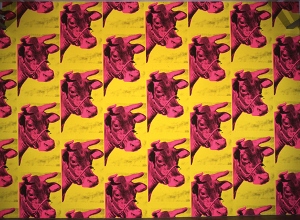Background
According to Warhol, the inspiration for the cow image came from art dealer Ivan Karp:
"Why don't you paint some cows, they're so wonderfully pastoral and such a durable image in the history of the arts." (Ivan talked like this.) I don't know how "pastoral" he expected me to make them, but when he saw the huge cow heads — bright pink on a bright yellow background — that I was going to have made into rolls of wallpaper, he was shocked. But after a moment he exploded with: "They're super-pastoral! They're ridiculous! They're blazingly bright and vulgar!" I mean, he loved those cows and for my next show we papered all the walls in the gallery with them. [2]
The cow image is believed to have come from E.S. Harrison's book, Judging Dairy Cattle. [3]
Some art critics have suggested Warhol appropriated the idea from Yayoi Kusama's One Thousand Boats Show (1963). In this installation work, Kusama wallpapered the gallery with 999 identical images of a boat sculpture. [4] [5]
This page is based on this
Wikipedia article Text is available under the
CC BY-SA 4.0 license; additional terms may apply.
Images, videos and audio are available under their respective licenses.
